Abstract
OBJECTIVE: To assess the exercise limitation of patients with chronic heart failure (CHF) and its relation to possible pulmonary and ventilatory abnormalities. SETTING: A tertiary referral centre for cardiology. METHODS: The metabolic gas exchange responses to maximum incremental treadmill exercise were assessed in 55 patients with CHF (mean (SD) age 57.9 (13.0) years; 5 female, 50 male) and 24 controls (age 53.0 (11.1) years; 4 female, 20 male). Ventilatory response was calculated as the slope of the relation between ventilation and carbon dioxide production (VE/VCO2 slope). RESULTS: Oxygen consumption (VO2) was the same at each stage in each group. Ventilation (VE) was higher in patients at each stage. Patients had a lower peak VO2 and a steeper VE/VCO2 slope than controls. Dead space ventilation as a fraction of tidal volume (VD/VT) was higher in patients at peak exercise, but dead space per breath was greater in controls at peak exercise (0.74 (0.29) v 0.57 (0.17) litres/breath; P = 0.002). End tidal CO2 was lower in patients at all stages, and correlated with peak VO2 (r = 0.58, P < 0.001). Alveolar oxygen tension was higher in patients at each stage than in controls. CONCLUSIONS: Patients with CHF have an increased ventilatory response at all stages of exercise. Although this is accompanied by an increase in VD/VT, there is hyperventilation relative to blood gases. It is more likely that the excessive ventilation is not due to a primary pulmonary pathology, but rather, the increase in dead space is likely to be a response to increased ventilation.
Full text
PDF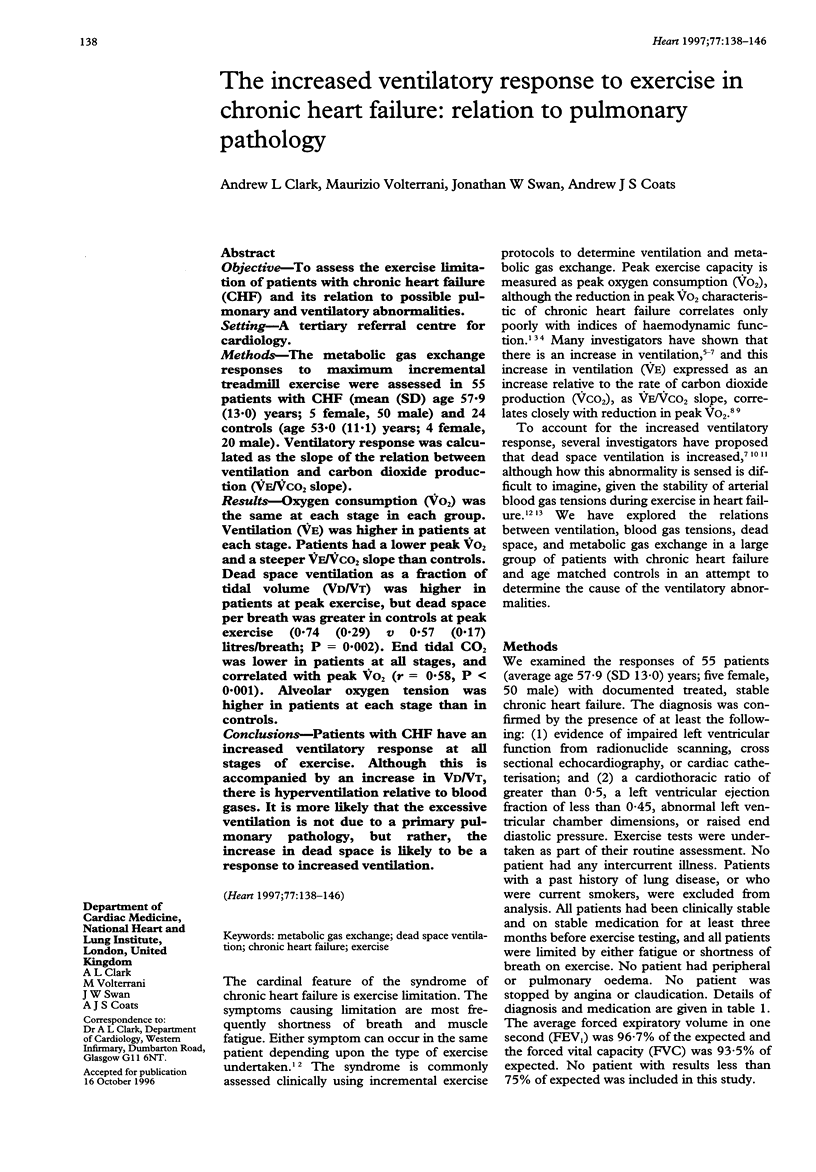
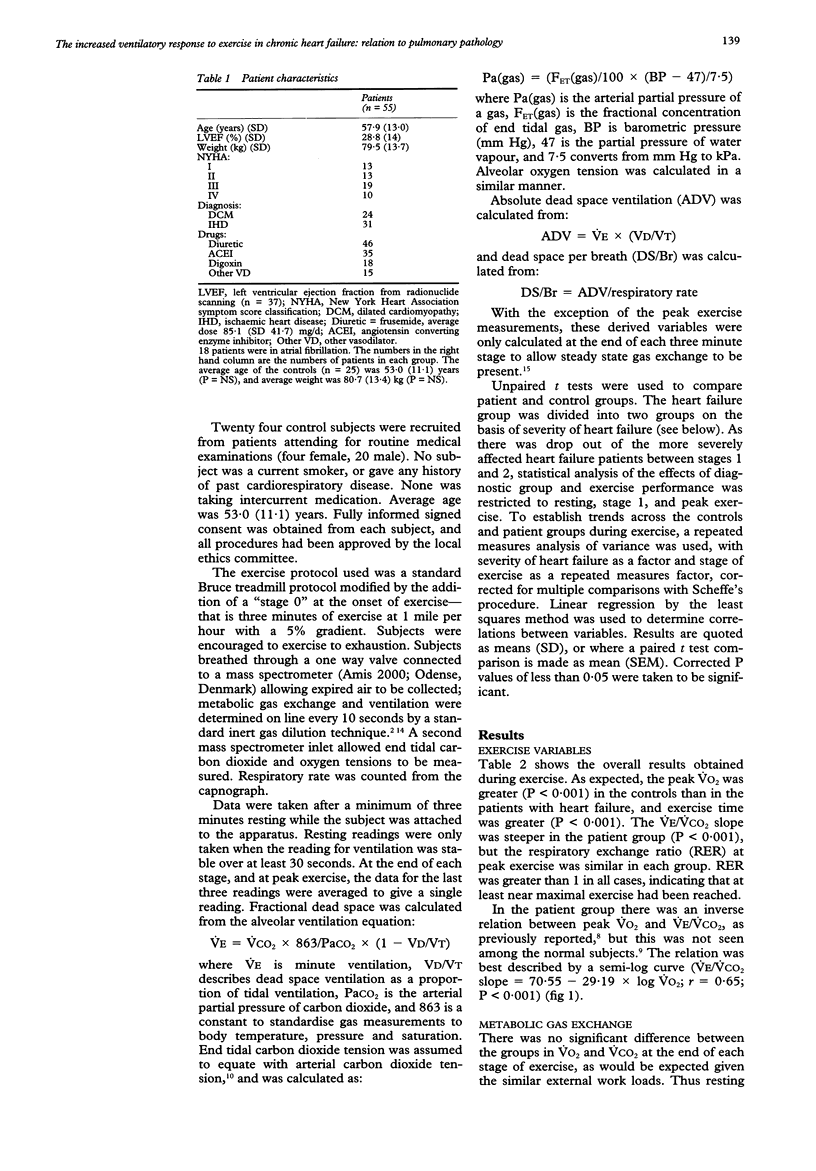
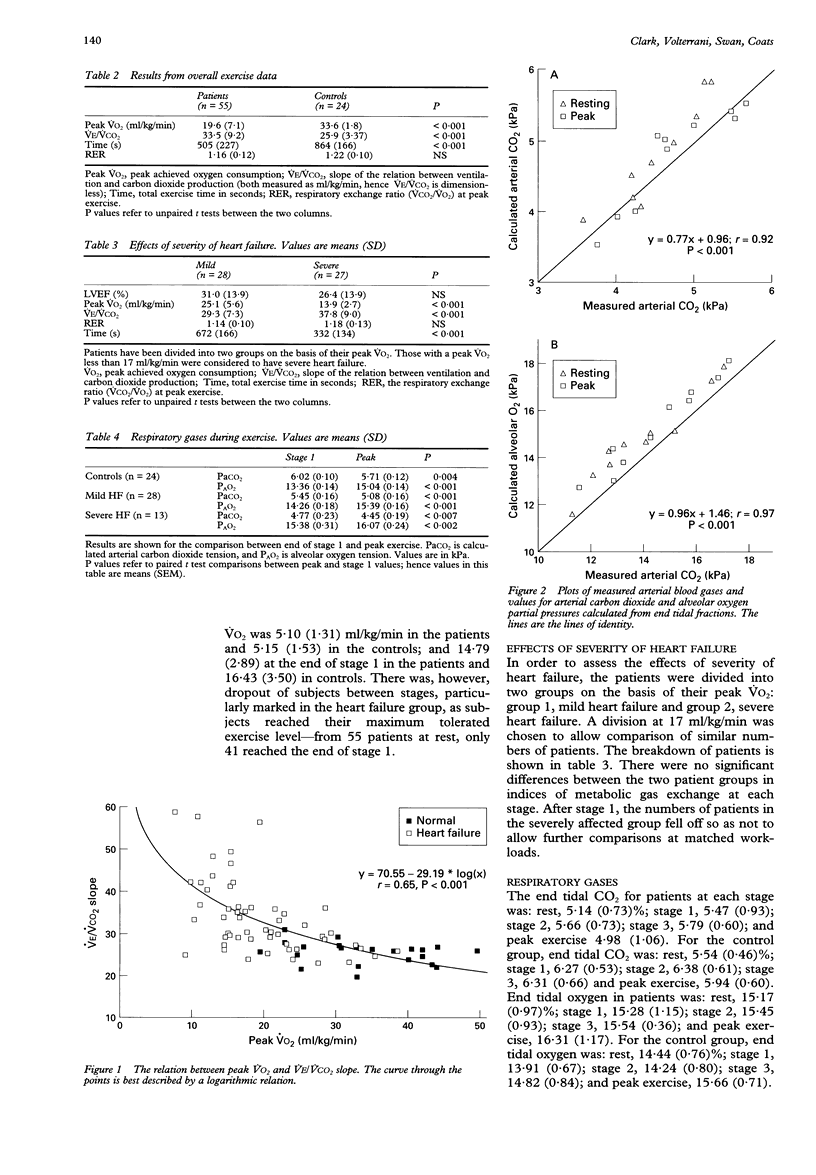
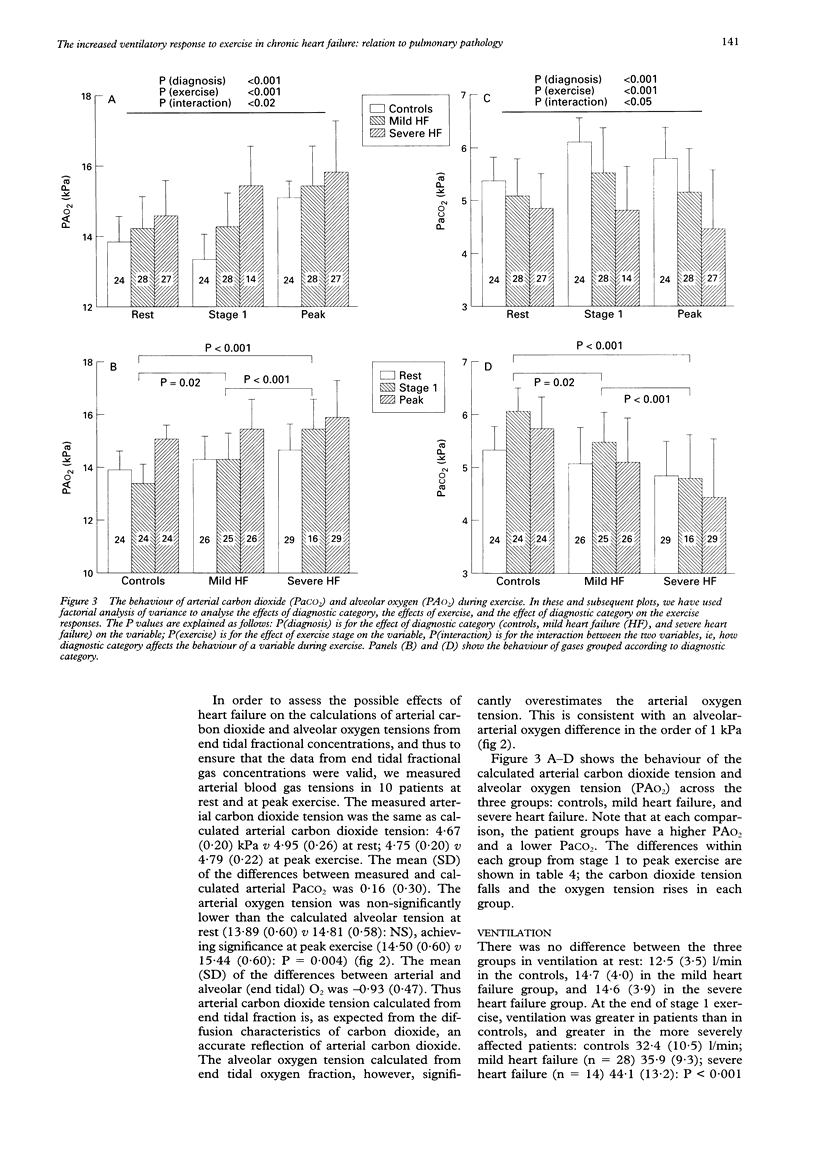
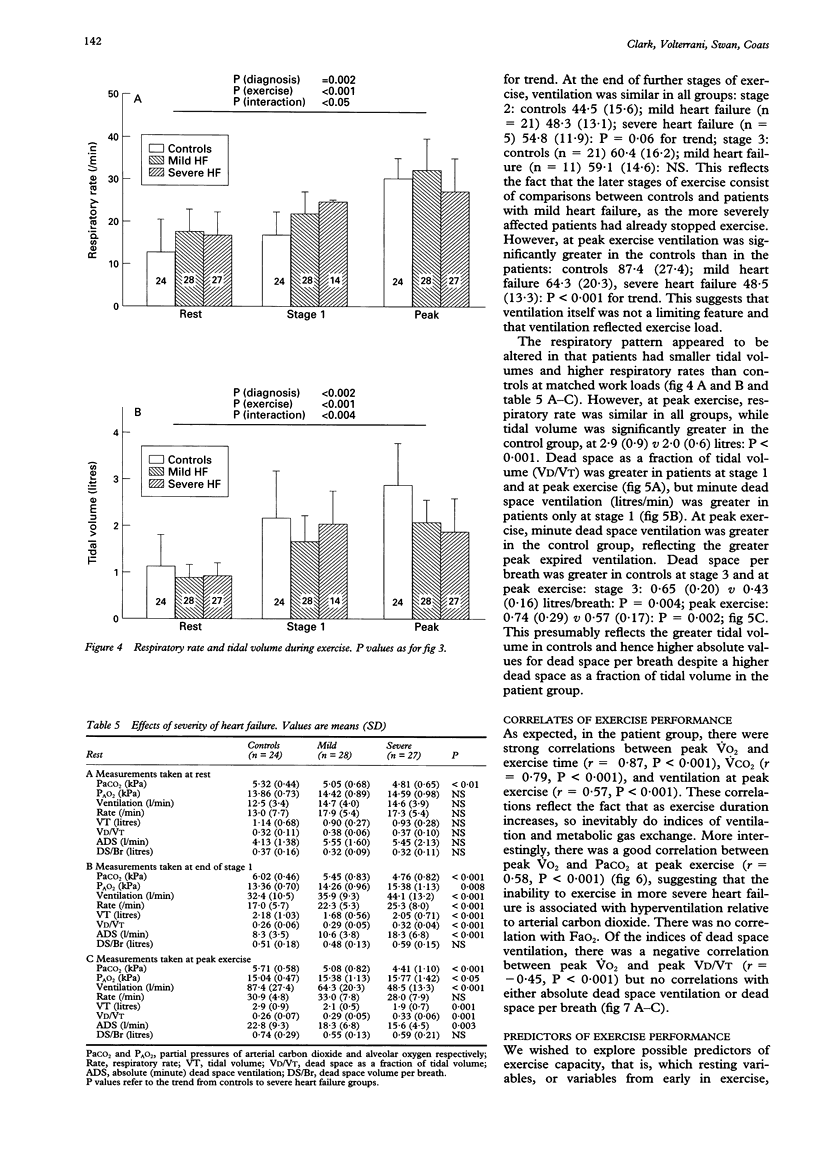
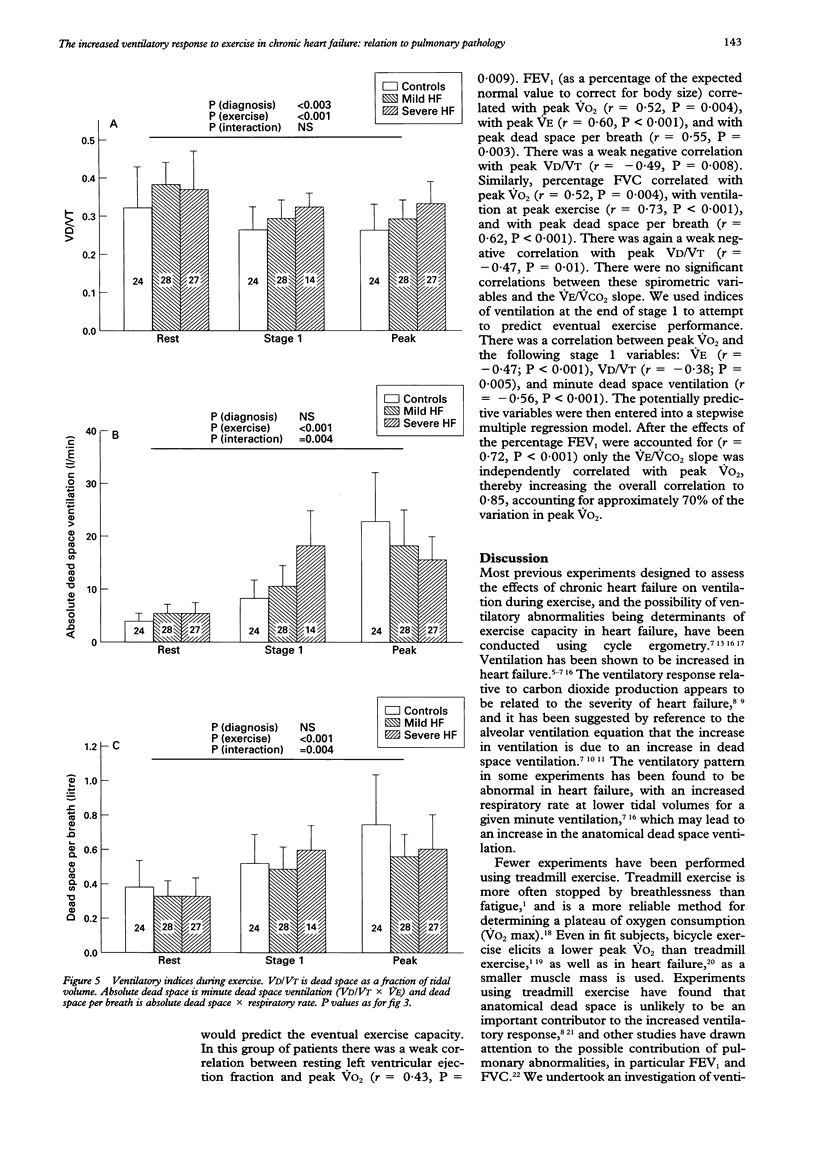
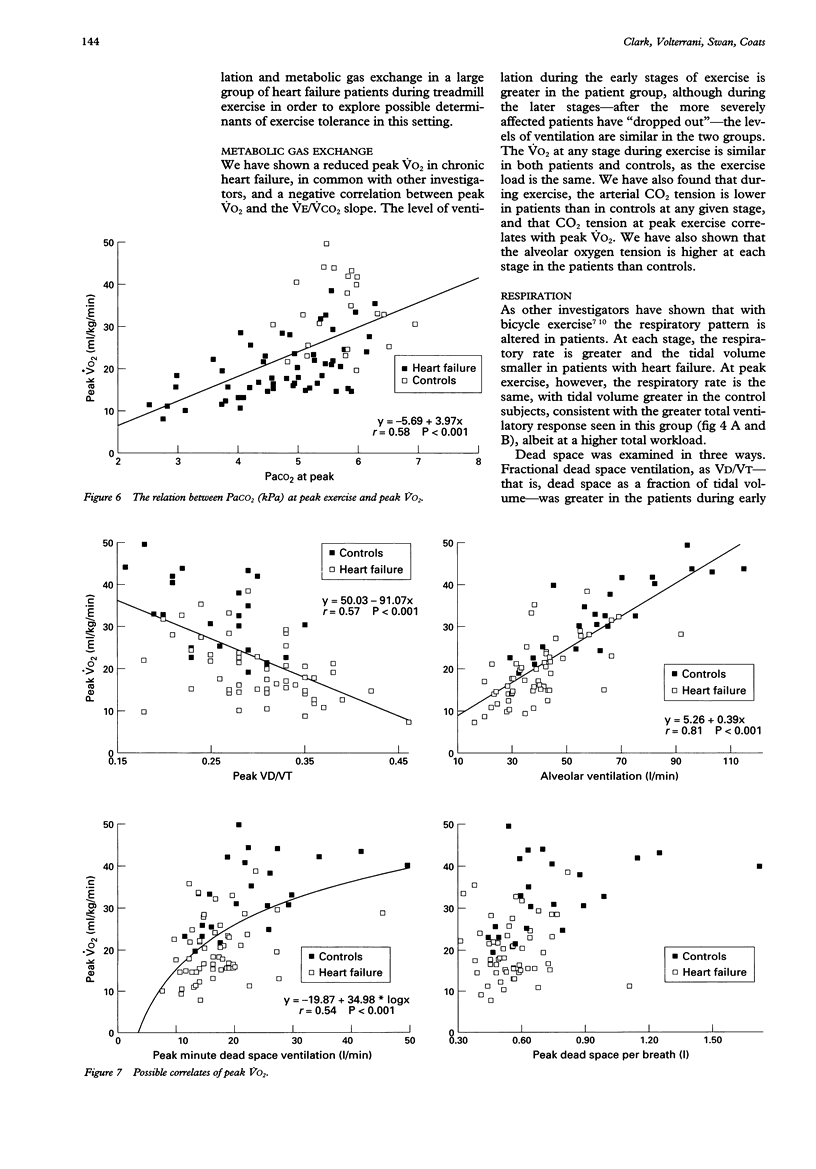
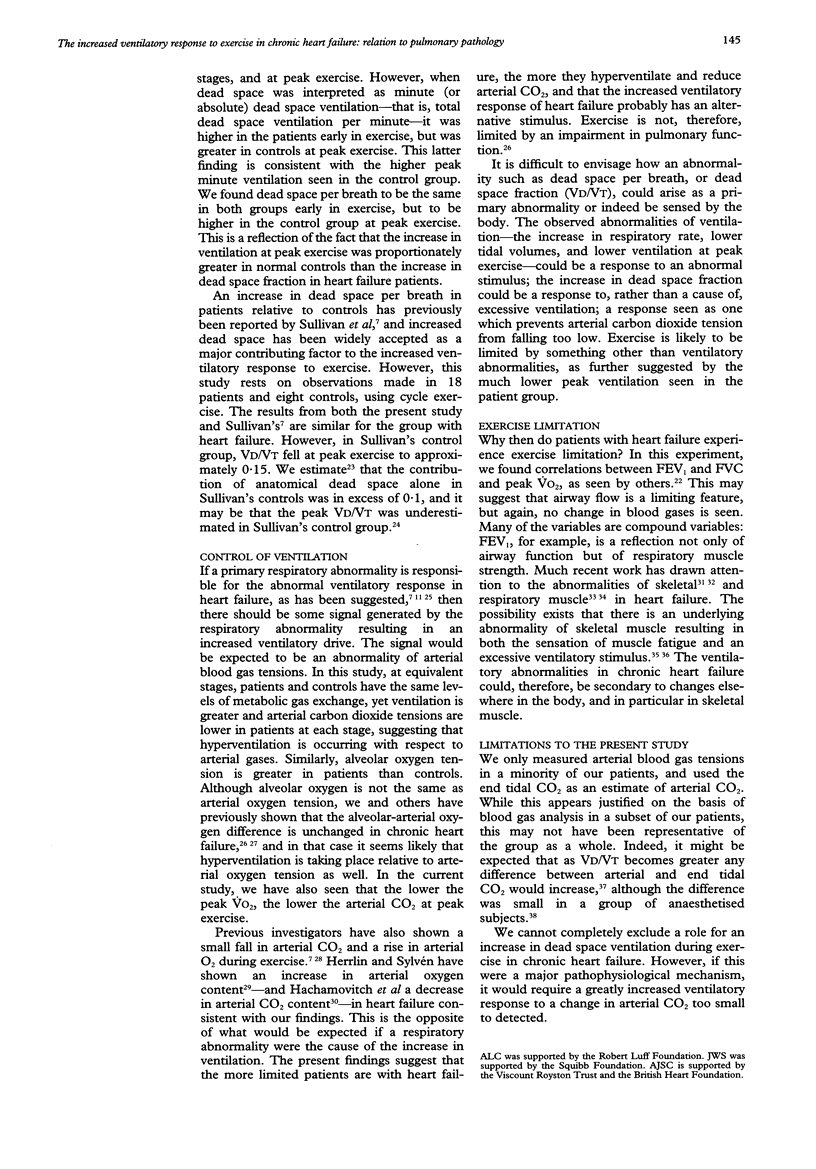
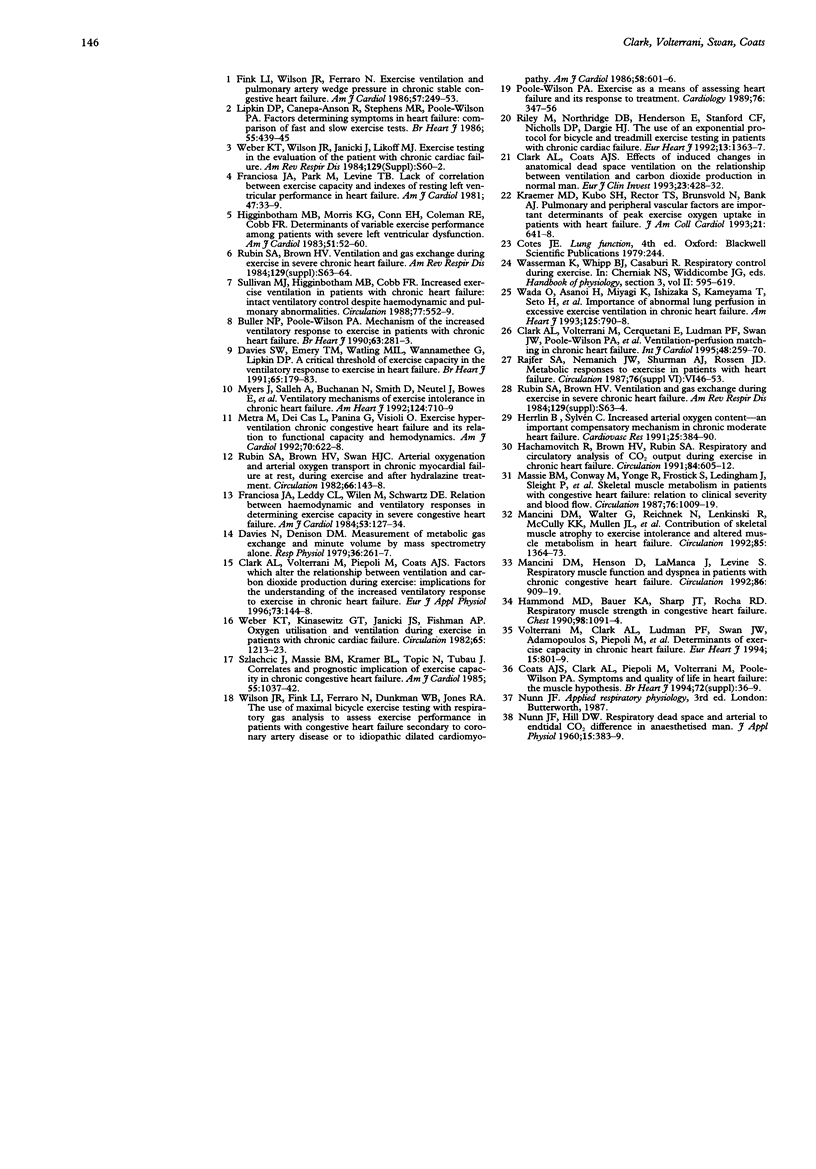
Selected References
These references are in PubMed. This may not be the complete list of references from this article.
- Buller N. P., Poole-Wilson P. A. Mechanism of the increased ventilatory response to exercise in patients with chronic heart failure. Br Heart J. 1990 May;63(5):281–283. doi: 10.1136/hrt.63.5.281. [DOI] [PMC free article] [PubMed] [Google Scholar]
- Clark A. L., Coats A. J. Relationship between ventilation and carbon dioxide production in normal subjects with induced changes in anatomical dead space. Eur J Clin Invest. 1993 Jul;23(7):428–432. doi: 10.1111/j.1365-2362.1993.tb00786.x. [DOI] [PubMed] [Google Scholar]
- Clark A. L., Volterrani M., Piepoli M., Coats A. J. Factors which alter the relationship between ventilation and carbon dioxide production during exercise in normal subjects. Eur J Appl Physiol Occup Physiol. 1996;73(1-2):144–148. doi: 10.1007/BF00262823. [DOI] [PubMed] [Google Scholar]
- Clark A. L., Volterrani M., Swan J. W., Coats A. J. Ventilation-perfusion matching in chronic heart failure. Int J Cardiol. 1995 Mar 3;48(3):259–270. doi: 10.1016/0167-5273(94)02267-m. [DOI] [PubMed] [Google Scholar]
- Davies N. J., Denison D. M. The measurement of metabolic gas exchange and minute volume by mass spectrometry alone. Respir Physiol. 1979 Feb;36(2):261–267. doi: 10.1016/0034-5687(79)90029-x. [DOI] [PubMed] [Google Scholar]
- Davies S. W., Emery T. M., Watling M. I., Wannamethee G., Lipkin D. P. A critical threshold of exercise capacity in the ventilatory response to exercise in heart failure. Br Heart J. 1991 Apr;65(4):179–183. doi: 10.1136/hrt.65.4.179. [DOI] [PMC free article] [PubMed] [Google Scholar]
- Fink L. I., Wilson J. R., Ferraro N. Exercise ventilation and pulmonary artery wedge pressure in chronic stable congestive heart failure. Am J Cardiol. 1986 Feb 1;57(4):249–253. doi: 10.1016/0002-9149(86)90900-8. [DOI] [PubMed] [Google Scholar]
- Franciosa J. A., Leddy C. L., Wilen M., Schwartz D. E. Relation between hemodynamic and ventilatory responses in determining exercise capacity in severe congestive heart failure. Am J Cardiol. 1984 Jan 1;53(1):127–134. doi: 10.1016/0002-9149(84)90696-9. [DOI] [PubMed] [Google Scholar]
- Franciosa J. A., Park M., Levine T. B. Lack of correlation between exercise capacity and indexes of resting left ventricular performance in heart failure. Am J Cardiol. 1981 Jan;47(1):33–39. doi: 10.1016/0002-9149(81)90286-1. [DOI] [PubMed] [Google Scholar]
- Hachamovitch R., Brown H. V., Rubin S. A. Respiratory and circulatory analysis of CO2 output during exercise in chronic heart failure. Circulation. 1991 Aug;84(2):605–612. doi: 10.1161/01.cir.84.2.605. [DOI] [PubMed] [Google Scholar]
- Hammond M. D., Bauer K. A., Sharp J. T., Rocha R. D. Respiratory muscle strength in congestive heart failure. Chest. 1990 Nov;98(5):1091–1094. doi: 10.1378/chest.98.5.1091. [DOI] [PubMed] [Google Scholar]
- Herrlin B., Sylvén C. Increased arterial oxygen content--an important compensatory mechanism in chronic moderate heart failure. Cardiovasc Res. 1991 May;25(5):384–390. doi: 10.1093/cvr/25.5.384. [DOI] [PubMed] [Google Scholar]
- Higginbotham M. B., Morris K. G., Conn E. H., Coleman R. E., Cobb F. R. Determinants of variable exercise performance among patients with severe left ventricular dysfunction. Am J Cardiol. 1983 Jan 1;51(1):52–60. doi: 10.1016/s0002-9149(83)80010-1. [DOI] [PubMed] [Google Scholar]
- Kraemer M. D., Kubo S. H., Rector T. S., Brunsvold N., Bank A. J. Pulmonary and peripheral vascular factors are important determinants of peak exercise oxygen uptake in patients with heart failure. J Am Coll Cardiol. 1993 Mar 1;21(3):641–648. doi: 10.1016/0735-1097(93)90096-j. [DOI] [PubMed] [Google Scholar]
- Lipkin D. P., Canepa-Anson R., Stephens M. R., Poole-Wilson P. A. Factors determining symptoms in heart failure: comparison of fast and slow exercise tests. Br Heart J. 1986 May;55(5):439–445. doi: 10.1136/hrt.55.5.439. [DOI] [PMC free article] [PubMed] [Google Scholar]
- Mancini D. M., Henson D., LaManca J., Levine S. Respiratory muscle function and dyspnea in patients with chronic congestive heart failure. Circulation. 1992 Sep;86(3):909–918. doi: 10.1161/01.cir.86.3.909. [DOI] [PubMed] [Google Scholar]
- Mancini D. M., Walter G., Reichek N., Lenkinski R., McCully K. K., Mullen J. L., Wilson J. R. Contribution of skeletal muscle atrophy to exercise intolerance and altered muscle metabolism in heart failure. Circulation. 1992 Apr;85(4):1364–1373. doi: 10.1161/01.cir.85.4.1364. [DOI] [PubMed] [Google Scholar]
- Massie B., Conway M., Yonge R., Frostick S., Ledingham J., Sleight P., Radda G., Rajagopalan B. Skeletal muscle metabolism in patients with congestive heart failure: relation to clinical severity and blood flow. Circulation. 1987 Nov;76(5):1009–1019. doi: 10.1161/01.cir.76.5.1009. [DOI] [PubMed] [Google Scholar]
- Metra M., Dei Cas L., Panina G., Visioli O. Exercise hyperventilation chronic congestive heart failure, and its relation to functional capacity and hemodynamics. Am J Cardiol. 1992 Sep 1;70(6):622–628. doi: 10.1016/0002-9149(92)90202-a. [DOI] [PubMed] [Google Scholar]
- Myers J., Salleh A., Buchanan N., Smith D., Neutel J., Bowes E., Froelicher V. F. Ventilatory mechanisms of exercise intolerance in chronic heart failure. Am Heart J. 1992 Sep;124(3):710–719. doi: 10.1016/0002-8703(92)90282-z. [DOI] [PubMed] [Google Scholar]
- NUNN J. F., HILL D. W. Respiratory dead space and arterial to end-tidal carbon dioxide tension difference in anesthetized man. J Appl Physiol. 1960 May;15:383–389. doi: 10.1152/jappl.1960.15.3.383. [DOI] [PubMed] [Google Scholar]
- Poole-Wilson P. A. Exercise as a means of assessing heart failure and its response to treatment. Cardiology. 1989;76(5):347–356. doi: 10.1159/000174518. [DOI] [PubMed] [Google Scholar]
- Riley M., Northridge D. B., Henderson E., Stanford C. F., Nicholls D. P., Dargie H. J. The use of an exponential protocol for bicycle and treadmill exercise testing in patients with chronic cardiac failure. Eur Heart J. 1992 Oct;13(10):1363–1367. doi: 10.1093/oxfordjournals.eurheartj.a060067. [DOI] [PubMed] [Google Scholar]
- Rubin S. A., Brown H. V., Swan H. J. Arterial oxygenation and arterial oxygen transport in chronic myocardial failure at rest, during exercise and after hydralazine treatment. Circulation. 1982 Jul;66(1):143–148. doi: 10.1161/01.cir.66.1.143. [DOI] [PubMed] [Google Scholar]
- Rubin S. A., Brown H. V. Ventilation and gas exchange during exercise in severe chronic heart failure. Am Rev Respir Dis. 1984 Feb;129(2 Pt 2):S63–S64. doi: 10.1164/arrd.1984.129.2P2.S63. [DOI] [PubMed] [Google Scholar]
- Rubin S. A., Brown H. V. Ventilation and gas exchange during exercise in severe chronic heart failure. Am Rev Respir Dis. 1984 Feb;129(2 Pt 2):S63–S64. doi: 10.1164/arrd.1984.129.2P2.S63. [DOI] [PubMed] [Google Scholar]
- Sullivan M. J., Higginbotham M. B., Cobb F. R. Increased exercise ventilation in patients with chronic heart failure: intact ventilatory control despite hemodynamic and pulmonary abnormalities. Circulation. 1988 Mar;77(3):552–559. doi: 10.1161/01.cir.77.3.552. [DOI] [PubMed] [Google Scholar]
- Szlachcic J., Massie B. M., Kramer B. L., Topic N., Tubau J. Correlates and prognostic implication of exercise capacity in chronic congestive heart failure. Am J Cardiol. 1985 Apr 1;55(8):1037–1042. doi: 10.1016/0002-9149(85)90742-8. [DOI] [PubMed] [Google Scholar]
- Volterrani M., Clark A. L., Ludman P. F., Swan J. W., Adamopoulos S., Piepoli M., Coats A. J. Predictors of exercise capacity in chronic heart failure. Eur Heart J. 1994 Jun;15(6):801–809. doi: 10.1093/oxfordjournals.eurheartj.a060588. [DOI] [PubMed] [Google Scholar]
- Wada O., Asanoi H., Miyagi K., Ishizaka S., Kameyama T., Seto H., Sasayama S. Importance of abnormal lung perfusion in excessive exercise ventilation in chronic heart failure. Am Heart J. 1993 Mar;125(3):790–798. doi: 10.1016/0002-8703(93)90173-7. [DOI] [PubMed] [Google Scholar]
- Weber K. T., Kinasewitz G. T., Janicki J. S., Fishman A. P. Oxygen utilization and ventilation during exercise in patients with chronic cardiac failure. Circulation. 1982 Jun;65(6):1213–1223. doi: 10.1161/01.cir.65.6.1213. [DOI] [PubMed] [Google Scholar]
- Weber K. T., Wilson J. R., Janicki J. S., Likoff M. J. Exercise testing in the evaluation of the patient with chronic cardiac failure. Am Rev Respir Dis. 1984 Feb;129(2 Pt 2):S60–S62. doi: 10.1164/arrd.1984.129.2P2.S60. [DOI] [PubMed] [Google Scholar]
- Wilson J. R., Fink L. I., Ferraro N., Dunkman W. B., Jones R. A. Use of maximal bicycle exercise testing with respiratory gas analysis to assess exercise performance in patients with congestive heart failure secondary to coronary artery disease or to idiopathic dilated cardiomyopathy. Am J Cardiol. 1986 Sep 15;58(7):601–606. doi: 10.1016/0002-9149(86)90283-3. [DOI] [PubMed] [Google Scholar]


